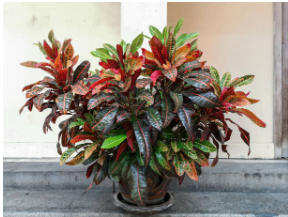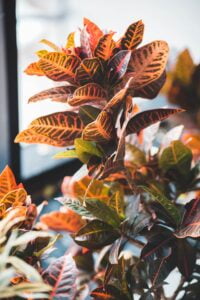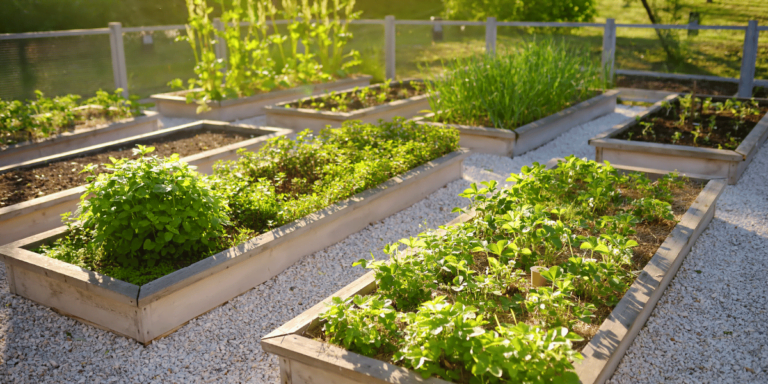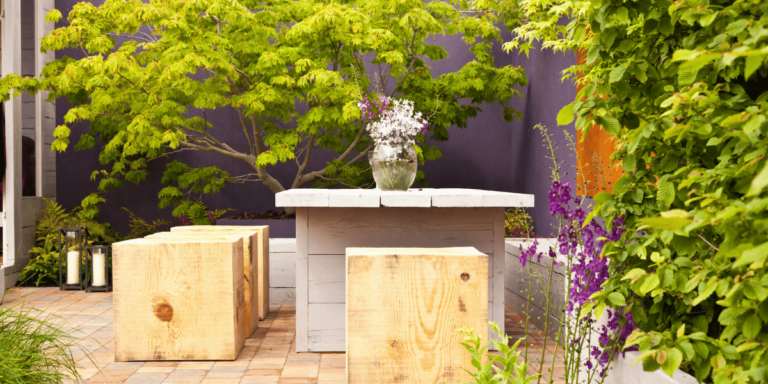Introduction:
The Indoor Plant Croton (Codiaeum variegatum) is a dazzling and vibrant houseplant, gracing homes with a burst of tropical flair. Renowned for its distinctively variegated leaves that encompass a spectrum of colors from greens to yellows, oranges, and even deep reds, the Croton is an unparalleled centerpiece in any indoor setting. In the following review, we’ll delve deeply into the best practices to care for and nurture this natural masterpiece to ensure its long-lasting beauty.
The Croton (Codiaeum variegatum) detailing key specifications:
| Specification | Details |
|---|---|
| Common Names | Croton, Variegated Croton |
| Botanical Name | Codiaeum variegatum |
| Family | Euphorbiaceae |
| Plant Type | Evergreen perennial |
| Mature Size | Typically 3 to 8 feet tall when grown indoors, but can reach heights of 10 feet in its native habitat. |
| Sun Exposure | Prefers bright, indirect sunlight. Can tolerate some direct sunlight, but not intense midday sun. |
| Soil Type | Well-draining potting mix, ideally a mix of regular potting soil, perlite, and sand. |
| Soil pH | Slightly acidic to neutral (6.1 to 7.5) |
| Bloom Time | Infrequent bloomer indoors. If it does bloom, it’s typically in the summer. |
| Flower Color | Small and inconspicuous, usually white or yellowish. Not the main attraction for this plant. |
| Hardiness Zones | 10 to 12 (for outdoor planting). It’s primarily grown as a houseplant in cooler zones. |
| Native Area | Native to the islands of the Pacific and East Indies, particularly Malaysia and the Solomon Islands. |
Plant Care:
Caring for the Croton isn’t as daunting as it might seem initially. While it does demand specific care, with consistent attention, this plant can thrive and showcase its brilliant foliage. Here, we’ll outline the step-by-step care instructions tailored for the Croton to ensure its optimal growth.
Light Requirements:
Crotons are light-loving plants. A position with bright, indirect sunlight will make their leaves sing with color. Direct sunlight, especially during the scorching midday hours, can be a tad too harsh, leading to leaf burn. Conversely, too little light can dull the vibrancy of the foliage. A spot near an east or west-facing window often works wonders.
Ideal Soil Conditions:
An airy and well-draining soil mix is paramount for Crotons. They dislike sitting in waterlogged conditions, which can precipitate root rot. A mixture of potting soil, perlite, and a bit of sand can offer the right balance of moisture retention and drainage. Remember, it’s always a good idea to ensure the pot has drainage holes.
Watering Protocols:
Watering the Croton is a balancing act. While it loves moisture, over-watering can be detrimental. It’s essential to water when the top inch of soil feels dry to the touch. During warmer months, you might find yourself watering more frequently, while in cooler months, the plant’s water requirements will diminish. Always ensure that excess water drains out to prevent root rot.
Temperature and Humidity Preferences:
Crotons revel in warm and humid conditions. They prefer temperatures between 60°F and 85°F. Avoid drastic temperature fluctuations, as Crotons are sensitive to cold drafts. To maintain humidity, especially during drier months, you can mist the leaves or place a humidifier nearby. A pebble tray with water can also help increase the surrounding humidity.
Fertilizer Recommendations:
Feed your Croton with a balanced liquid fertilizer every 4-6 weeks during the growing season (spring and summer). It’s always beneficial to follow the recommended dosage, as too much can lead to salt buildup. During fall and winter, the plant’s growth slows, so you can cut back on fertilizing.
Pruning Insights:
Pruning is an art that can accentuate the Croton’s beauty. Remove any yellow or damaged leaves to maintain the plant’s aesthetics and health. Additionally, if the plant becomes too leggy or overgrown, you can trim back the stems. This not only shapes the plant but also encourages more bushy growth.
Overwintering Techniques:
If you reside in an area with chilly winters, it’s crucial to protect your Croton. Keep it away from cold drafts, including those from windows or doors. Ensure it continues receiving bright light, and remember to reduce watering. Maintaining warmth and preventing any frost exposure will see your Croton through winter.
Propagation Methods:
Propagating Crotons can be a rewarding endeavor. The most successful method is stem cuttings. Take a 4-6 inch cutting, let it air dry for an hour, and then plant it in a pot with well-draining soil. Maintain humidity around the cutting, and with patience, you’ll soon see new growth.
Signs of Quick Decline:
While Crotons are hardy, certain signs might indicate trouble. Dropping leaves, fading colors, or signs of pests (like spider mites) can suggest the plant is stressed. By promptly addressing these issues, adjusting care routines, and potentially consulting a plant expert, you can help your Croton recover.
Types of Croton Plants:
The diversity within the Croton family is nothing short of mesmerizing. Different varieties boast unique leaf patterns, sizes, and colors. Some popular types include:
- Petra: This variety showcases broad, shiny leaves with green, yellow, red, and even orange hues.
- Mammy: Recognized by its spiraled, twisty leaves, Mammy Crotons burst with red, pink, and yellow shades.
- Zanzibar: With slender, wavy leaves, the Zanzibar is a cascade of greens, yellows, and reds.
- Gold Dust: True to its name, this Croton type has green leaves sprinkled with bright yellow spots.
By understanding the different types, enthusiasts can pick the one that best complements their indoor space.
Common Pests & Plant Diseases and Solutions:
Like all plants, Crotons can be vulnerable to certain pests and diseases:
- Spider Mites: These tiny pests can cause yellowing leaves. Solution: Remove them by wiping the leaves with a damp cloth or using insecticidal soap.
- Scale: Brown or tan bumps on leaves are often scale insects. Solution: Remove manually or use neem oil as a natural insecticide.
- Leaf Spot: This fungal disease causes brown spots on leaves. Solution: Ensure good air circulation, avoid overhead watering, and consider using a fungicide if the issue persists.
Regular inspections and prompt interventions can keep these issues at bay.
Encouraging Blooms in Croton Plants:
While Crotons are primarily cherished for their leaves, they can bloom under the right conditions. To encourage blooming:
- Optimal Light: Ensure they receive bright, indirect sunlight.
- Proper Fertilization: Use a balanced fertilizer during the growing season.
- Maintain Stress: Sometimes, a slight stress, like reducing watering a bit, can encourage them to bloom.
However, it’s important to note that indoor Crotons might not bloom as frequently as outdoor ones.
Common Problems with Croton Plants:
Several issues might arise when caring for Crotons:
- Leaf Drop: Usually a sign of stress which could be due to over-watering, under-watering, cold drafts, or sudden changes in lighting.
- Loss of Leaf Color: Insufficient light often dulls the vibrant colors of Croton leaves.
- Curling Leaves: This can indicate both over-watering and under-watering, so it’s crucial to monitor the soil moisture.
- Stunted Growth: If your Croton isn’t growing, it might need more light or nutrients. Consider moving it to a brighter location and ensuring its fertilizer needs are met.
Understanding these problems can aid in troubleshooting and restoring the plant to its pristine state.
Croton plants, with their vibrant foliage, can be the crown jewel of any plant collection. While they require particular attention to thrive, the results, as the leaves shine in their colorful splendor, are undoubtedly worth the effort.
Thriving Beyond Basics (Conclusion):
With consistent care, the Indoor Plant Croton (Codiaeum variegatum) can thrive and remain a breathtaking addition to any space. Understanding its needs, from light to water, ensures that this tropical beauty will continue to dazzle with its colorful display. Embrace the joy of nurturing a Croton, and it will surely reward you with its vibrant presence.
Frequently Asked Questions
Decode the magic of gardens with our guide to Landscaping Styles Frequently Asked Questions.
- Yes, in tropical or subtropical climates, Crotons can grow outdoors. However, they are frost-sensitive and must be protected in colder regions.
- Crotons contain certain compounds that can be toxic if ingested. It’s best to keep them away from curious pets.
- Leaf drop can be a reaction to stress, which could be due to over-watering, under-watering, or drastic temperature changes
- Repot every 2-3 years or when the plant becomes root-bound. Ensure the new pot has adequate drainage and use a well-draining soil mix.













